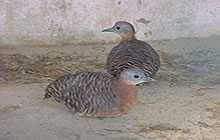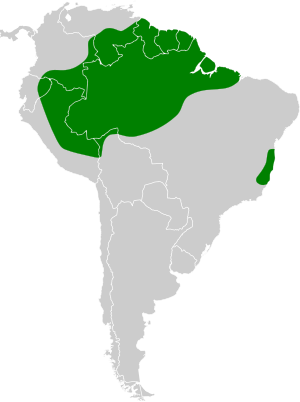Variegated tinamou facts for kids
Quick facts for kids Variegated tinamou |
|
|---|---|
 |
|
| Conservation status | |
| Scientific classification | |
| Genus: |
Crypturellus
|
| Species: |
variegatus
|
 |
|
The variegated tinamou (Crypturellus variegatus) is a special type of bird called a tinamou. It lives in wet, warm forests in northern South America. These birds are known for their beautiful, varied colors.
Contents
About the Variegated Tinamou
Scientists give every living thing a unique name. This helps them organize and study all the different plants and animals. This system is called taxonomy.
The variegated tinamou was first officially described in 1789. A German scientist named Johann Friedrich Gmelin gave it its first scientific name. Later, in 1914, British bird experts placed it in the group Crypturellus.
The name Crypturellus comes from ancient Greek words. It means "small hidden tail." The word variegatus is Latin and means "variegated" or "having varied colors." This fits the bird's look!
All tinamous belong to the family Tinamidae. They are also part of a larger group of birds called ratites. Other ratites include ostriches and emus. Unlike most ratites, tinamous can fly, but they are not very strong flyers. Scientists believe tinamous are the closest living relatives to ancient flying birds.
What Does It Look Like?
The variegated tinamou is about 29.5 to 33 centimeters (11.6 to 13 inches) long. Its upper back is a reddish-brown color. Its lower back and wings are black with bright yellowish stripes.
Its throat is white, and its neck and upper chest are bright reddish-brown. The lower chest and belly are a light, creamy color. Its sides have a mix of cinnamon and dark stripes. The top of its head and sides of its face are black. It has a yellow beak and greenish to yellowish-brown legs.
These birds have a special call. It sounds like five shaky, even notes. Sometimes the notes blend into a long, trembling sound. The first note is always clear and goes down in pitch.
Where It Lives
The variegated tinamou lives in humid, low-lying forests. These forests have thick plants growing close to the ground. You can find them in southern and eastern Colombia and southern Venezuela. They also live in French Guiana, Suriname, and Guyana.
They are found in the Amazon Rainforest in Brazil, eastern Peru, and eastern Ecuador. You can also see them in northern Bolivia. They usually live at heights of 100 to 1300 meters (330 to 4265 feet) above sea level.
Behavior and Reproduction
Like other tinamous, the variegated tinamou eats fruit. They find fruit on the ground or on low bushes. They also eat small bugs, flower buds, and soft leaves. Sometimes they eat seeds and roots too.
When it's time to have babies, the male tinamou does most of the work. He sits on the eggs to keep them warm. These eggs might come from up to four different females! After the chicks hatch, the male raises them. They are ready to live on their own in about two to three weeks. The nest is usually on the ground. It is hidden in thick bushes or between large tree roots.
Conservation Status
The IUCN (International Union for Conservation of Nature) keeps track of animals. They list the variegated tinamou as "Least Concern." This means that its population is stable and not currently in danger. It lives across a very large area, about 5,400,000 square kilometers (2,100,000 square miles).
See also
 In Spanish: Tinamú abigarrado para niños
In Spanish: Tinamú abigarrado para niños


